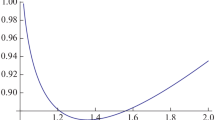Summary
We quantize a model for a hadron consisting of a fermion field localized on a string. It is found that the resulting system is covariant only in 26 −n space-time dimensions, wheren is the number of independent fields. Further it turns out that there are two possible choices for the resulting system, depending on the boundary conditions imposed, and that in one case it is possible to have a negative leading-trajectory intercept even in the absence of other (scalar) fields.
Riassunto
Si quantizza un modello per un adrone consistente in un campo fermionico localizzato su una corda. Si trova che il sistema risultante è covariante solo in 26 −n dimensioni di spazio-tempo, doven è il numero dei campi indipendenti. Inoltre si trova che ci sono due scelte possibili per il sistema risultante dipendenti dalla condizione di contorno imposta e che in un caso è possibile avere un intercetto negativo per la traiettoria principale anche in assenza di altri campi (scalari).
Реэюме
Мы квантуем модель для адрона, состояшего иэ фермионного поля, локалиэованного на струне. Обнаружено, что реэультируюшая система является ковариантной только в случае 26−n пространственно-вре менных иэмерений, гдеn есть число неэависимых полей. Кроме того, окаэывается, что сушествует два воэможных выбора для реэультируюшей системы, в эависимости от налагаемых граничных условий, и что в одном случае воэможно иметь отрицательное пересечение главной траектории, даже при отсутствии других (скалярных) полей.
Similar content being viewed by others
Literatur
A. Strumìa andG. Venturi:Lett. Nuovo Cimento,13, 337 (1975).
For a review of string approaches to hadron structure seeC. Rebbi:Phys. Rep.,12 C, No. 1 (1974);S. Mandelstam:Phys. Rep.,13 C, No. 6 (1974);J. Scherk:Rev. Mod. Phys.,47, 123 (1975).
G. Venturi:Nuovo Cimento,26 A, 97 (1975);31 A, 79 (1976).
G. Venturi:Nuovo Cimento,32 A, 484 (1976).
In general, wherever possible, we shall follow the approach for the usual dual string as given inP. Goddard, J. Goldstone, C. Rebbi andC. B. Thorn:Nucl. Phys.,56 B, 107 (1973).
Actually we also need (see (ref.) (5).
S. Mandelstam:Nucl. Phys.,69 B, 71 (1974).
Author information
Authors and Affiliations
Rights and permissions
About this article
Cite this article
Strumìa, A., Venturi, G. Quantum strings and fermions. Nuov Cim A 35, 45–57 (1976). https://doi.org/10.1007/BF02730059
Received:
Published:
Issue Date:
DOI: https://doi.org/10.1007/BF02730059



